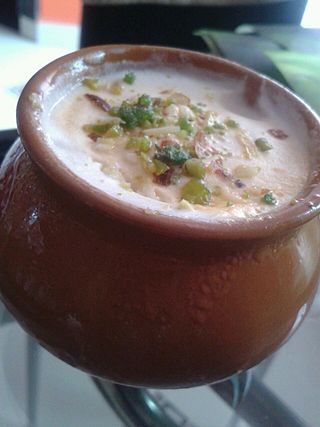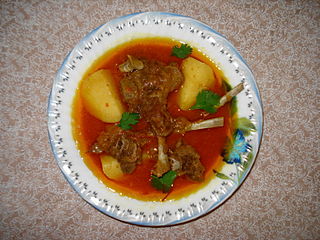
Halva is a type of confectionery originating from Persia (Iran) and widely spread throughout the Middle East and North Africa, the Balkans, and South Asia. The name is used for a broad variety of recipes, generally a thick paste made from flour, butter, liquid oil, saffron, rosewater, milk, turmeric powder, and sweetened with sugar.
Indian cuisine consists of a variety of regional and traditional cuisines native to the Indian subcontinent. Given the diversity in soil, climate, culture, ethnic groups, and occupations, these cuisines vary substantially and use locally available spices, herbs, vegetables, and fruits.

Punjabi cuisine is a culinary style originating in the Punjab, a region in the northern part of South Asia, which is now divided in an Indian part to the east and a Pakistani part to the west. This cuisine has a rich tradition of many distinct and local ways of cooking.

Kulfi is a frozen dairy dessert from the Indian subcontinent. It is often described as "traditional Indian ice cream". Kulfi originated in 16th-century Delhi during the Mughal era. It is part of the national cuisines of India and Pakistan. It is also popular in Bangladesh, Myanmar, Nepal, Sri Lanka, and the Middle East.

A falooda is a Mughalai cold dessert made with vermicelli. It has origins in the Persian dish faloodeh, variants of which are found across West, Central, South and Southeast Asia. Traditionally it is made by mixing rose syrup, vermicelli, and sweet basil seeds with milk, often served with ice cream. The vermicelli used for preparing falooda is made from wheat, arrowroot, cornstarch, or sago.
Mithai (sweets) are the confectionery and desserts of the Indian subcontinent. Thousands of dedicated shops in India, Bangladesh, Nepal, Pakistan and Sri Lanka sell nothing but sweets.
Maharashtrian or Marathicuisine is the cuisine of the Marathi people from the Indian state of Maharashtra. It has distinctive attributes, while sharing much with other Indian cuisines. Traditionally, Maharashtrians have considered their food to be more austere than others.

Sindhi cuisine refers to the distinct native cuisine of the Sindhi people from Sindh, Pakistan. Sindhi cuisine has been influenced by Central Asian, Iranian, Mughal food traditions. It is mostly a non-vegetarian cuisine, with even Sindhi Hindus widely accepting of meat consumption. The daily food in most Sindhi households consists of wheat-based flat-bread (Mani) or rice accompanied by two dishes, one gravy and one dry with curd, papad or pickle. Freshwater fish and a wide variety of vegetables are usually used in Sindhi cuisine. Restaurants specializing in Sindhi cuisine are rare, although it is found at truck stops in rural areas of Sindh province, and in a few restaurants in urban Sindh.
Hyderabadi cuisine, also known as Deccani cuisine, is the cooking style characteristic of the city of Hyderabad and its surrounding area in Telangana, India.

Ghevar or Ghewar is a disc-shaped Rajasthani sweet with a honeycomb-like texture, made from ghee, maida, and sugar syrup. It is traditionally associated with the month of Shraavana and the festivals of Teej and Raksha Bandhan. It is a part of Rajasthani tradition and is gifted to newly married daughter on Sinjara, the day preceding Gangaur and Teej. It is also one of the Chhapan Bhog served to the Lord Krishna. Besides Rajasthan, it is also famous in the adjoining states of Haryana, Delhi, Gujarat, Uttar Pradesh, and Madhya Pradesh.
Cuisine of Uttar Pradesh is from the state of Uttar Pradesh (UP) located in Northern India. The cuisine of UP has a large variety of dishes. The cuisine consists of both vegetarian and non-vegetarian dishes of different varieties. Being a large state, the cuisine of UP share lot of dishes and recipes with the neighboring states of Delhi, Uttarakhand, Bihar, Jharkhand and Haryana. Braj, Awadhi, Kannuaji, Kauravi, Bundeli, Bagheli and Bhojpuri are famous subtypes of cuisine of the state.
Awadhi cuisine is a cuisine native to the Awadh region in Northern India and Southern Nepal. The cooking patterns of Lucknow are similar to those of Central Asia, the Middle East, and Northern India and western India with the cuisine comprising both vegetarian and non-vegetarian dishes. The Awadh region has been influenced by Mughal cooking techniques, and the cuisine of Lucknow bears similarities to those of Central Asia, Kashmir, Punjab and Hyderabad. The city is also known for its Nawabi foods.

Aloo gosht is a meat curry, and is a popular dish in North Indian, Pakistani, and Bangladeshi cuisine. It consists of potatoes (aloo) cooked with meat (gosht), usually lamb or mutton or beef, in a stew-like shorba gravy. It may be considered a curry, stew, or shorba depending on the way the dish is prepared, the types of spices used and what country or particular region it was made in. The dish can be served and eaten with plain rice or with bread such as roti, paratha or naan.

Gajar ka halwa, also known as Gajorer halwa, Gajarno halwo, Gajrela, Gajar pak, and carrot pudding is a carrot-based sweet dessert pudding made by placing grated carrots in a pot containing a specific amount of water, milk, sugar, and cardamom and then cooking while stirring regularly. It is often served with a garnish of almonds and pistachios. The nuts and other items used are first sautéed in ghee, a type of clarified butter from the Indian subcontinent.

Saraiki cuisine refers to the native cuisine of the Saraiki people in central Pakistan. It is one of the key part of the Pakistani and South Asian cuisines. The style of cooking is present in the Saraiki-speaking region of southern Punjab, as well as parts of southern Khyber Pakhtunkhwa, northern Sindh and northeastern Balochistan. Saraiki food comprises many unique local dishes, and also shares influences with neighbouring regional cuisines. The metropolitan city of Multan is a hub of Saraiki cooking.

Suji ka Halwa or Mohan Bhog is a type of halvah made by toasting semolina in a fat like ghee or oil, and adding a sweetener like sugar syrup, honey, or jaggery powder. It can be served for breakfast or as a dessert item. The basic recipe is made with just semolina, sugar or honey, ghee, and sometimes milk. Variations on this include dried or fresh fruits, nuts, shredded coconut, and other toppings. Wheat flour is often used as a substitute if semolina is not available, but virtually any starch can be used to make Suji ka Halwa.
























































![attprthm[?].JPG](http://upload.wikimedia.org/wikipedia/commons/thumb/e/e3/%E0%B4%85%E0%B4%9F%E0%B4%AA%E0%B5%8D%E0%B4%B0%E0%B4%A5%E0%B4%AE%E0%B5%BB.JPG/120px-%E0%B4%85%E0%B4%9F%E0%B4%AA%E0%B5%8D%E0%B4%B0%E0%B4%A5%E0%B4%AE%E0%B5%BB.JPG)











































